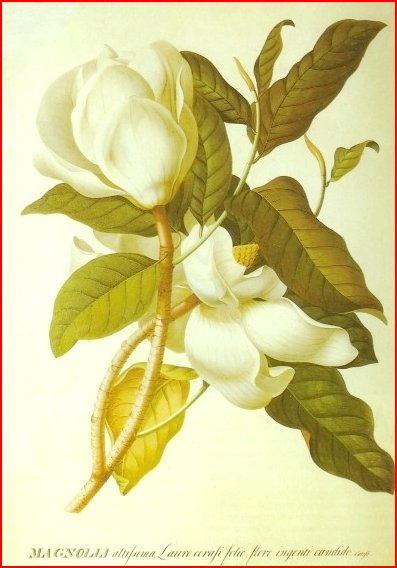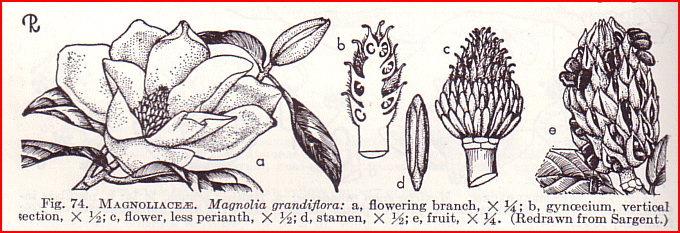

Magnolia
Compiled and edited by Ivor
Hughes
Magnolia. U.S. 1850. (USD 1926 Monograph)
Magnolia Bark.-Three species of Magnolia were formerly official as follows:
Magnolia glauca L., Small or Laurel Magnolia, : M. acuntinata L. or Cucumber-tree, and M. tripetala L., commonly known as Umbrella tree (Fam. Magnoliaceae) In the fruit of the latter Wallace Procter found a neutral crystalline principle, magnolin.
When pure, this is without odor and has at first little taste, in consequence of its insolubility in the liquids of the mouth, but after a time produces an irritant effect on the fauces.
It is nearly insoluble in cold, but slightly soluble in hot water, very soluble in alcohol or ether. Procter considered it analogous to the liriodendrin obtained by Emmet, but quite distinct..
It has been also found in other species. (See A. J. P., 1372, 145; also Lloyd's paper in Ph. Rund., 1866, 224.) W. F. Rawlins (A. J. P., 1889, 7) ) obtained from the leaves of M. glauca a small quantity of a volatile oil of bright green color, with an odor resembling fennel or anise, but more pleasant..
From the ethereal solution of this oil small crystals deposited. Indications were also obtained of a bitter glucosidal principle
The bark and fruit of all the species of Magnolia are possessed of similar properties; but the bark only was official, and that of the root was thought to be most efficient.
The bark from young wood is quilled or curved, thin, externally orange-brown and glossy, or light gray, with scattered warts and somewhat fissured, internally 'whitish or pale brownish and smooth; fracture short, in the inner layer somewhat fibrous; inodorous; taste somewhat astringent, pungent, and bitter.
The bark of old wood, deprived of the cork, is whitish or brownish, fibrous, and less pungent." U.S. 1880. The aromatic property, which resides in a volatile principle, is diminished by desiccation, and entirely lost when the bark is long kept. The bitterness, however, remains. The bark is destitute of astringency.
Magnolia is a gently stimulant aromatic tonic and diaphoretic. It has been used in malaria and in rheumatism. The dose of the recently dried bark in powder is from half a drachm to a drachm (2.0 - 3.9 Gm.). frequently repeated.
The following diagram is from 'The Manual of Cultivated Plants' By L. H. Bailey and the staff of Hortorium Cornell University.

Boerickes Homoeopathic Materia Medica and Repertory.
MAGNOLIA GRANDIFLORA
(Magnolia)
Rheumatism and cardiac lesions are prominent features in the symptomatology of this drug. Stiffness and soreness. Alternating pains between spleen and heart. Patient tired and stiff. Soreness when quiet. Erratic shifting of pains.
Heart.- Oppression of chest with inability to expand the lungs. Feeling of a large bolus of food which distressed the stomach. Suffocated feeling when walking fast or lying on left side. Dyspnoea. Crampy pain in heart. Angina pectoris. Endocarditis and pericarditis.Tendency to faint. Sensation as if heart had stopped beating. Pain around heart accompanied by itching of the feet.
Extremities.- Stiffness and sharp erratic pains; worse in joints. Feet itch. Numbness in left arm. Rheumatic pain in clavicles. Shooting in all limbs.
Modalities.-Worse, damp air, lying on left side; in morning on first rising. Better, dry weather, motion; intermenstrual flow. [Ham.; Bovista; Bell.; Elaps.]
Relationship.- Compare: Rhus.; Dulcam.; Aurum. Dose.-Third potency.
![]()